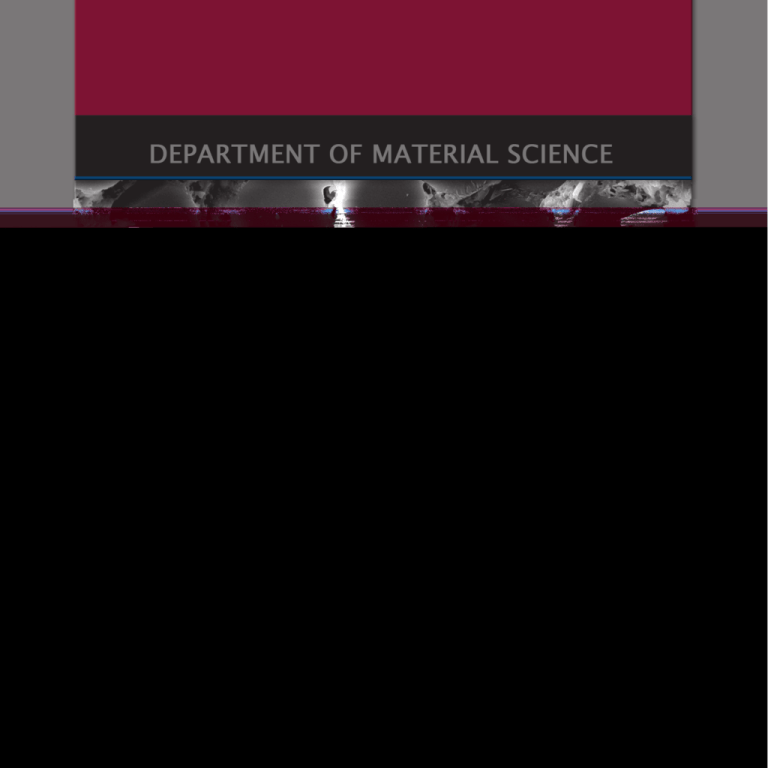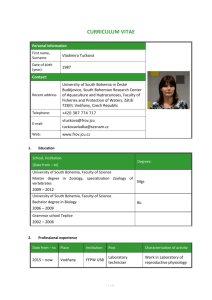Untitled - Technical University of Liberec
advertisement

Department of Material Science Material Science and Engineering Technologies were first taught two years after the Technical University of Liberec was founded in 1953. Since this time, the Department of Material Science has provided tuition at a foundational and a departmental level for both undergraduates and those taking a Master’s or Ph.D. in Engineering. The department teaches subjects such as Physical Metallurgy and Corrosion, and Surface Layers Technologies to those specialising in engineering technologies. The department provides tuitition for those specialising in Material Engineering. The Department of Material Science teaches Material Science I and II and similar materials subjects to students of the Faculty of Mechanical Engineering as well as to those from other Technical Faculties of the TUL during their undergraduate studies. Research Focus The research activity of the department focuses on these aspects of material engineering: thermal treatment, surface testing of materials, surface treatment, thin layers, intermetallics, polymer materials, composites and technical ceramics. Projects (selected) • Project GA106/06/0019 – Fe-40 at.% Al based alloys as a basis for high temperature applications (2006-2008, GA0/GA). • AVČR No. 1Q S100 100508 – doc. Skrbek – internal No. 1707 – Non-destructive testing of structures of cast iron with magnetic adaptive method. • MPO No. 6359/07/03400/155 – FT-T O4/068 – Advanced armed geopolymer composites for technical applications – prof. Ing. Petr Louda, CSc. • AVČR No. IAA 800020603 – Ing. Kubíček – internal No. 1602 Technics of knife manufacturing of the early Middle Ages. Technology and quality variability of selected part of archaeology sources from the viewpoint of metallography research. Main investigator: Archaeology Institute – Academy of Sciences of Czech Republic Prague Ing. Jiří Hošek, Ph.D. • MŠMT No. 1M 0577 – NANOPIN – internal No. 1772, 1972 – Ing. Aleš Kolouch, Ph.D. – Research Center for Nanosurface Engineering. • GAČR No. 106/08/P0005 – Ing. Pavel Hanus, Ph.D. – Treatment of high temperature creep properties of iron aluminide of type Fe3Al by additives. 18 • GAČR No. 106/08/1665 – prof. RNDr. Špatenka, CSc. – Study of plasma modified polyolefins and their properties from the point of view of their applications as anticorrosion coatings. • MŠMT research project – No. 4674788501 – internal No. 1452 – System interconnection of method of mathematical and physical modeling of temperature, tension and structure conditions in the confrontation with verification experiments on real bodies, parts or machines. • Project MPO – TANDEM ID: FT-TA4/012 – Integrity of surface as an instrument for useful properties enhancement made on machines from TOS Varnsdorf, a.s. – Ing. Václav Kubíček. Services and Expertise on Offer • • • • Mechanical static testing. Hardness testing. Impact toughness testing. Procedures of heat treatments – heat treatments of metals: annealing, quenching, age-hardening, heat treatment. • Surface roughness testing – Ra measurement with graphic record and statistic data evaluation. • Spectral analysis of chemical composition – determination of the composition of metal materials Light optical microscopy. • Macroscopic assessment of structures – metallography: quality assessment of equilibrium and nonequilibrium heat treatments and chemical-heat treatments of ferro-alloys and non-ferrous metals and other materials. Image digitizing and microstructure colour printing, image analysis LUCIA. Microhardness measurement using Hanemann and Reichert microhardness tester. • Electron microscopy – scanning electron microscopy, magnification accordace with sample nature 500x-10 000x. Surface quality assessment of metal materials: surface defects, fractography analysis, localisation of specific defects (point corrosion, fretting, etc.). • Advisory services and consulting in the field of technical and scientific research: Optimising heat treatment and chemical-heat treatment processes. Surface treatment (plasma technologies), choice of materials. Finding equivalent metal materials from abroad (and vice versa). Reliability of technological processes and systems. • Expert activity in the field of research: Faults in the technology of heat treatment and chemical-heat treatment, vacuum heat treatment, replacing the materials of machine components during mechanism failure. • Nondestructive testing. • Evaluating surface properties. Laboratories, Instruments and Equipment Research and collaboration on industrial projects are carried out in following laboratories: Metalography Laboratory This laboratory houses modern equipment for preparing metallography sections as well as instruments for evaluation of structure. The machine equipment for preparing metallographic sections is from BUEHLER comp. and includes a DELTA abrasive cutter, an ISOMET 1000 high-precision diamond saw; a SIMPLIMET 1000 automatic electro-hydraulic press and a SIMPLIMET 2 manual press for mounting samples. It also has a BETA grinder and polisher with a VECTOR automatic head. Optical and Electron microscopes are available for investigating structures. The optical microscopes are EPIPHOT 200 (NIKON) with digital camera, DS-5M-U1 (NIKON), and NEOPHOT 32 equipped with digital camera COOLPIX 4500 (NIKON). The structures photographed can be evaluated using Nis-elements software version 3.0. For microfractographic analysis, a TESLA BS 343 scanning electron microscope with PC image treatment (modul SATELLITE) can be used. The laboratory is also equipped with a MICROMET 2100 (BUEHLER) microhardness tester with camera, and LUCIA G version 4.60 software with the module HARDNESS. Electron Microscopy Laboratory The laboratory is equipped with a TESLA BS 343 scanning electron microscope and has a modernised connection to a Satellite module (Tescan) to make image analysis possible. The microscope is used for fractographic analysis and surface evaluation of metal materials. Laboratory for NDT Methods This laboratory contains a whole range of instruments which enable defectoscopic and structuroscopic NDT of materials. It contains all issues of standards and periodicals. Thanks a grant (No. 1710) the laboratory is able to hold practical educational classes as well as be an aid to industry. RT – radiographic methods of testing – methodology background only. UT – ultrasound methods, PT – capillary methods, MT – magnetic method: basic instrument equipment. ET – eddy currents – instruments for thickness measurement on conductive substrates. VT – visual method – gauges for evaluation of welds and surfaces, magnifying glasses. IT – infrared defectoscopy – by laser-directed point thermometer. PoT – potentiometric tests – crack depth and conductivity measurer. Mechanical Testing Laboratory Tensile testing machine for static loading Hardness testers (Brinell, Vickers, Rockwell), dynamic hardness testers 19 Impact toughness tester (Charpy PSW 5) Tester for deep-drawing sheet (Erichsen) Three box furnaces for heat treatment Significant Research Results and their Application The study of composite systems preparation based on polymer matrices reinforced with natural plant fibres was completed and assessed. The process of the vibration damping study was proposed. This procedure can be used for the complex analysis of the reinforcement filler selection, the filler volume and the material interface. The single-purpose apparatus for measuring vibration-damping was designed and constructed. The mathematical model was formulated which combines the influence of temperature, thickness, wall curvature and cupper content in the wall of ferromagnetic material assessed. The study of combining acoustic and magnetic tests for evaluating ferromagnetic material was awarded a certificate: No. 17830 “The Apparatus for Nondestructive Assessment of Material Quality”. Laboratory and semindustrial tests of the corrosion resistance of iron aluminium alloys in molten glass were carried out in cooperation with the company Preciosa a.s. Materials suitable for the production of semi-finished products created by hot rolling were selected. Iron aluminium alloys creep tests at high temperatures were completed. These tests were conducted under conditions which reflect the final use of the materials. Other tribologic tests were carried out on thin, hard and nonabrasive wear layers based on titanium and carbon on a steel base. Their surface wear was assessed and compared with materials commonly used in the car industry. A new series of biocompatible thin carbon layers on polymer and metal substrates were developed by PA CVD technology in cooperation with the Technical University of Lodž. These layers were tested in vitro. The possibility of creating these thin layers on nanofibre materials produced by the company Elmarco was tested. The study of the plasma modification of powder polymer materials was continued. In addition, studies were carried out into using the materials treated as polymer coatings on metal substrates. Experiments were carried out using two methods of modification – a low pressure microwave discharge, and a 20 barrier discharge under atmospheric pressure. The materials modified by both methods show a significant increase in their hydrophility, with long-time stability. Systems for industrial modification of powder materials using a low pressure microwave discharge were proposed. Experiences with the plasma modification of powder materials were also used during experiments on biological materials. Expert Collaboration Polytechnika Łódzka, Poland Techno-Coat Oberflächentechnik GmbH Zittau, Germany Internationales Hochschulinstitut Zittau, Germany Université de Franche-Comte, Besanson, France Université de technologie Belfort-Montbéliard, France Fachhochschule Hannover, Germany Dr. Holger Kersem, Greifsfeld, (in the field of powder modification), Germany Fraunhofer Institute for Applied, Golm, Germany Institut Chemische technologie, Berghausen, Germany Arplas GmbH, Thalheim, Germany Patents, Inventions, Utility Designs • ŠPATENKA PETR PROF. RNDR. CSC, ČESKÉ BUDĚJOVICE, CZ. Device for low-pressure plasma modification of powder and granulated materials. Author: Špatenka Petr Prof. RNDr. CSc, České Budějovice, CZ. Int. Cl.7: H05H 1/42 B29B 9/16. Czech Republic. Utility design 15563. 2005-06-20. • ŠPATENKA PETR PROF. RNDR. CSC, ČESKÉ BUDĚJOVICE, CZ. Device for atmospheric plasma modification of powder and granulated materials. Authors: Špatenka Petr Prof. RNDr. CSc, České Budějovice, CZ Hladík Jan Ing., Hořiněves, CZ Píchal Jan Doc. RNDr. CSc, Praha, CZ. Int. CI.: B01J 19/08. Czech Republic. Utility design 17564. 2006-06-26. • SKS KRNOV, A. S., KRNOV, CZ. Device for non-destructive control of the material qualities. Authors: Šajgál Jaroslav, Krnov, CZ Jedinák Antonín, Vrbno pod Pradědem, CZ Marek Jiří, Brno, CZ Jakub Jiří, Brno, CZ Ryšavý Richard, Brno, CZ Skrbek Břetislav, Jablonec nad Nisou, CZ. Int. Cl.: G01N 27/27 G01N 27/80 G01N 29/04. C. Czech Republic. Utility design 18306. 2007-03-19.



